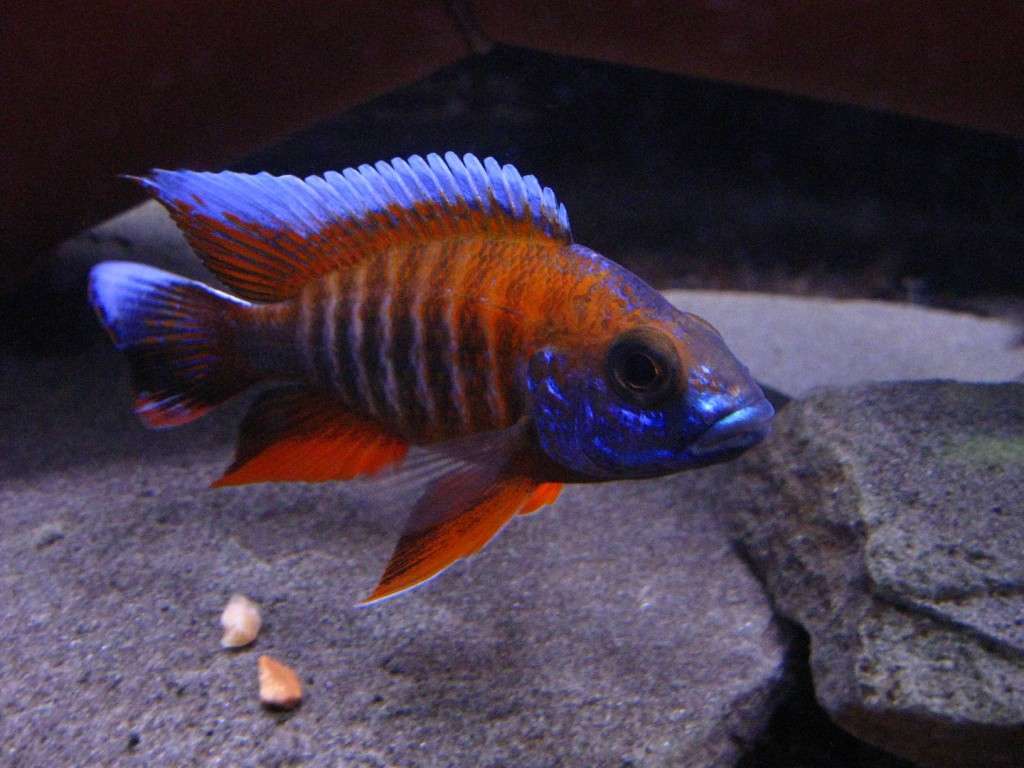
Size
5.9 inches
Physical Characteristics and Behavior
The Jacobfreibergi Peacock, a member of the peacock family, has a red body and a blue head with brilliant blue and black stripes. The dorsal and anal fins of males are “pointed” and considerably longer than those of females. Fins of female fish tend to be more rounded. On their anal fins, certain males and a very tiny proportion of females exhibit brilliant egg spots.
Keeping as a Pet

- Care of Aquariums
Peacock fish are tough, but they will lose health under low water conditions, much like all Malawi cichlids. Since the pH of the Malawi fish is often higher, ammonia is more dangerous, necessitating frequent water changes. They produce a lot of waste since they mostly consume protein-rich diets, which adds to the biological load on the filtration system. Depending on the bio load, the tank will require water changes of between 20 and 50% per week.
Weekly water changes of 20–50% are advised because these dirty fish produce a lot of bio load.
- Setup of an aquarium
Lake Malawi receives its water from streams that are rich in minerals. Alkaline water that is heavily mineralized is the result of this combined with evaporation. In terms of pH and other water chemistries, Lake Malawi is renowned for its transparency and stability. It is simple to understand why it is crucial to keep an eye on tank parameters when using any Lake Malawi fish.
Brackish waters are not home to rift lake cichlids because they require hard, alkaline water. To raise the carbonate hardness of the water, still salt is occasionally used as a buffering agent. Thankfully, this cichlid can tolerate some salt. It may be kept in slightly brackish water, but it is not suitable for a tank with fully brackish water. It can withstand a specific gravity of less than 1.0002 and a low salinity of 10% of a typical saltwater tank.
For a single fish, a 55-gallon aquarium is sufficient, but for a school of fish, 75 gallons or more is advised. They may survive in freshwater or slightly brackish freshwater, but they require strong and effective filtration as well as good water movement. Crushed coral can assist maintain a high pH level when added to gravel, which makes a suitable substrate. In general, crushed coral or aragonite sands dissolve more readily than salts. However, keeping a higher pH makes ammonia more deadly, thus regular water changes are essential for these fish.
Just be sure to leave open spaces along the bottom of the tank as well. Some rock decor is useful for creating hiding places and areas of escape. These fish require a lot of space to swim both at the bottom and in the middle of the tank. They favour dim lighting. However, one benefit of these fish is that they do not harm plants as much as other cichlids, allowing you to add some to your decor if you like.
A 55 gallon minimum tank size is recommended for a single fish, and 75 gallons or more for a group. Minimum Tank Size: 55 gal (208 L)
Appropriate for Nano Tank: No
They love muted lighting. Substrate Type: Any
Lighting Needs: Low – subdued lighting
Brackish: Salt is not always present in their native environment, but they do have a modest tolerance; keep levels below 10% and less than 1.0002 in terms of specific gravity.
Moving Water: Moderate
Center Water Region: These fish will move around the aquarium’s middle and bottom.
- Water Conditions
A. Jacobfreibergi can be found in the wild in the majority of rocky areas and areas with both a rocky and a sandy component. Throughout the aquarium, there should be extensive stretches of rocky terrain and even caverns. The water should be 25°C (77°F) in temperature, have an 8 pH, and 15°dGH of hardness.
- Feeding
Generally speaking, the African Butterfly Peacock is a carnivorous cichlid. In the wild, they eat crustaceans as well as zooplankton, particularly larvae. Give them high-quality cichlid flake or pellet food as their main source of nourishment in the tank, along with meaty supplements. Meaty feeds that are pelleted, frozen, live, or freeze-dried, including brine shrimp, bloodworms, and daphnia, are wonderful options. Avoid tubifex worms because they cause “Malawi bloat,” a sickness. Additionally, shrimp mixes like the European Shrimp Mix, which are as nutrient-dense and more affordable than other prepared foods, can be used.
If they are not breeding, feed them 5 to 6 times a week as adults and once daily when they are young. Avoid the urge to feed this fish more frequently than necessary because doing so will help to maintain greater water quality for a longer period of time.
Table





